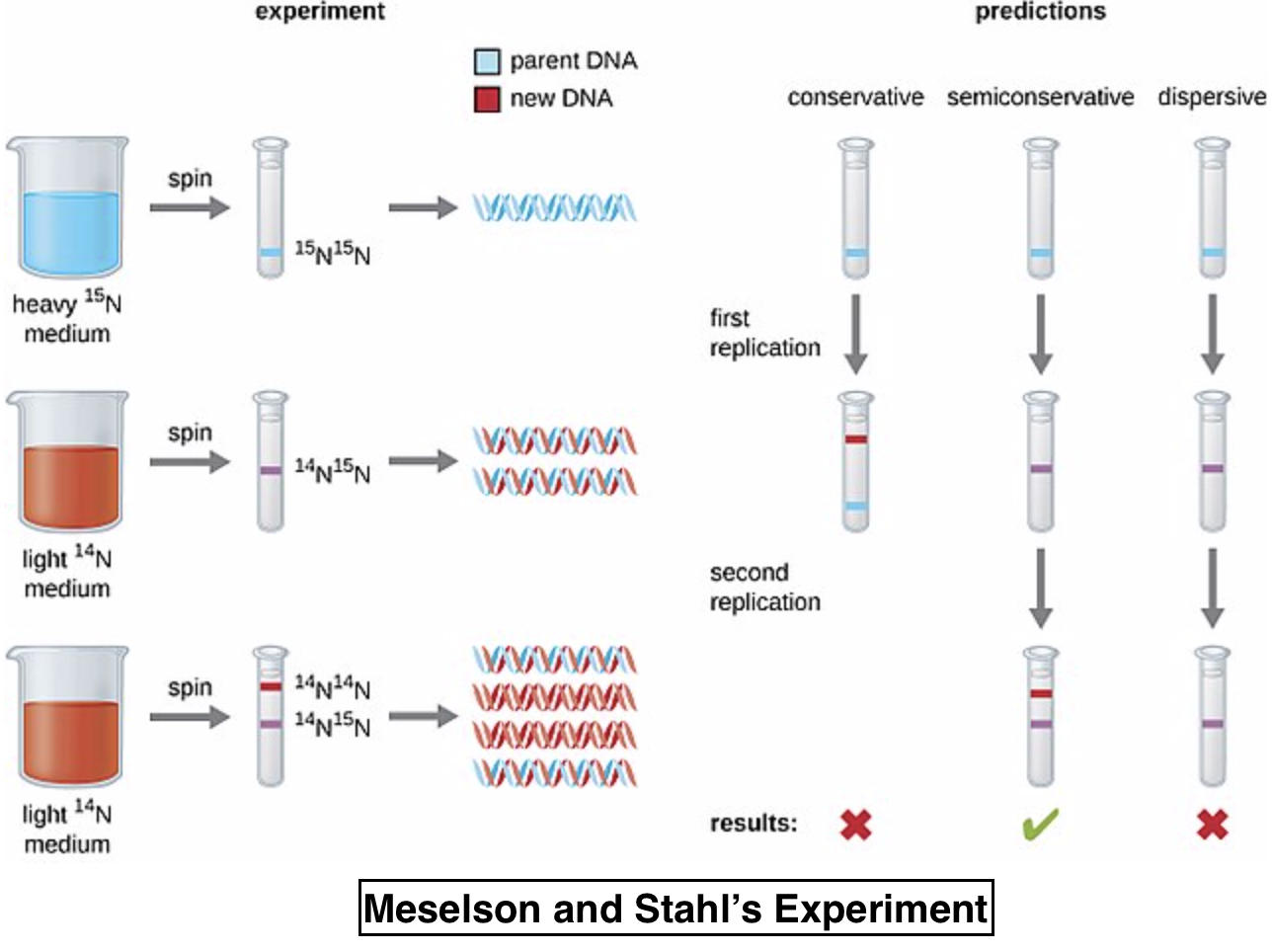
If Meselson and Stahl’s experiment is continued for four generations in bacteria, the ratio of $_{ }^{ 15 }{ N }_{ }^{ 15 }{ N }$, $_{ }^{ 15 }{ N }_{ }^{ 14 }{ N }$, $_{ }^{ 14 }{ N }_{ }^{ 14 }{ N }$ containing DNA in the fourth generation would be?
(a) 1:1:0
(b) 1:4:0
(c) 0:1:3
(d) 0:1:7
Answer
480.3k+ views
Hint: The semi-conservative nature of DNA replication was proposed by Watson and Crick but its experimental verification was done by Meselson and Stahl in Escherichia coli using a heavy isotope of nitrogen $_{ }^{ 15 }{ { N } }$ and a centrifuge.
Complete Answer:
Watson and Crick explained that the parental DNA strand would act as a template for the formation of a new strand, thus each new DNA strand would have a parental strand along with a newly synthesized strand. This phenomenon was termed as the semi- conservative nature of DNA replication (as half parental DNA was conserved).

Meselson and Stahl’s experiment proving this nature is as follows:
- E.coli was grown in a $_{ }^{ 15 }{ { NH }_{ 4 } }{ Cl }$ medium thus allowing $_{ }^{ 15 }{ { N } }$ to be incorporated into the DNA strand of this bacteria.
- Now, this bacteria was transferred to a plate containing normal $_{ }^{ 14 }{ { NH }_{ 4 } }{ Cl }$ where it was allowed to grow.
- Centrifugation after each generation of E.coli showed the presence of $_{ }^{ 15 }{ N }_{ }^{ 14 }{ N }$ hybrid DNA which indicated that the $_{ }^{ 15 }{ { N } }$ strand of DNA came from the parental strand.
- By the time we reach the fourth generation, there will be no parental $_{ }^{ 15 }{ N }_{ }^{ 15 }{ N }$ DNA strands left as they were utilized in making the hybrid strands.
- There will be 2 strands having $_{ }^{ 15 }{ N }_{ }^{ 14 }{ N }$ i.e. hybrids and 14 strands having $_{ }^{ 14 }{ N }_{ }^{ 14 }{ N }$ i.e. pure strands.
So, the correct option is ‘0:1:7’.
Note:
- Similar experiments were performed by Taylor in faba beans using radioactive thymine in 1958.
- The centrifuge used had a CsCl density gradient.
- The time required for E.coli to produce a new generation is 20 minutes.
Complete Answer:
Watson and Crick explained that the parental DNA strand would act as a template for the formation of a new strand, thus each new DNA strand would have a parental strand along with a newly synthesized strand. This phenomenon was termed as the semi- conservative nature of DNA replication (as half parental DNA was conserved).

Meselson and Stahl’s experiment proving this nature is as follows:
- E.coli was grown in a $_{ }^{ 15 }{ { NH }_{ 4 } }{ Cl }$ medium thus allowing $_{ }^{ 15 }{ { N } }$ to be incorporated into the DNA strand of this bacteria.
- Now, this bacteria was transferred to a plate containing normal $_{ }^{ 14 }{ { NH }_{ 4 } }{ Cl }$ where it was allowed to grow.
- Centrifugation after each generation of E.coli showed the presence of $_{ }^{ 15 }{ N }_{ }^{ 14 }{ N }$ hybrid DNA which indicated that the $_{ }^{ 15 }{ { N } }$ strand of DNA came from the parental strand.
- By the time we reach the fourth generation, there will be no parental $_{ }^{ 15 }{ N }_{ }^{ 15 }{ N }$ DNA strands left as they were utilized in making the hybrid strands.
- There will be 2 strands having $_{ }^{ 15 }{ N }_{ }^{ 14 }{ N }$ i.e. hybrids and 14 strands having $_{ }^{ 14 }{ N }_{ }^{ 14 }{ N }$ i.e. pure strands.
So, the correct option is ‘0:1:7’.
Note:
- Similar experiments were performed by Taylor in faba beans using radioactive thymine in 1958.
- The centrifuge used had a CsCl density gradient.
- The time required for E.coli to produce a new generation is 20 minutes.
Recently Updated Pages
Express the following as a fraction and simplify a class 7 maths CBSE

The length and width of a rectangle are in ratio of class 7 maths CBSE

The ratio of the income to the expenditure of a family class 7 maths CBSE

How do you write 025 million in scientific notatio class 7 maths CBSE

How do you convert 295 meters per second to kilometers class 7 maths CBSE

Write the following in Roman numerals 25819 class 7 maths CBSE

Trending doubts
Give 10 examples of unisexual and bisexual flowers

Draw a labelled sketch of the human eye class 12 physics CBSE

Differentiate between homogeneous and heterogeneous class 12 chemistry CBSE

Differentiate between insitu conservation and exsitu class 12 biology CBSE

What are the major means of transport Explain each class 12 social science CBSE

Franz thinks Will they make them sing in German even class 12 english CBSE




